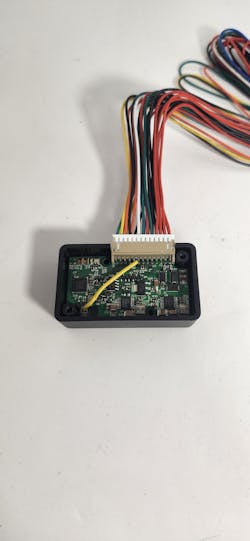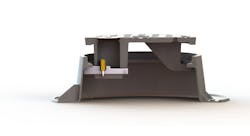Eight years ago, Greg Waugh saw the future of security: electronic access control (EAC).
To be sure, he wasn’t the first and only one with such a vision. Waugh is president and CEO of PACLOCK, which makes padlocks — not a product that one normally associates with EAC — but after a chance encounter at a trade show, Waugh saw a way for PACLOCK to do something different.
“What I saw was a tremendous opportunity leveraging the newer wireless standards that are out there, especially Bluetooth [Low Energy],” he says. “That was going to be a game-changer. Even though I manufacture physical padlocks, I’m a geek at heart. It just seemed to make sense.”
The “it” is PAC-BLU. After several fits and starts, PACLOCK finally is ready to unleash PAC-BLU on the general public. By the time you read this, it should be available through PACLOCK’s distributor network. (It actually has been in the field for a few years at a couple locations, Waugh says.)
“We’re ready to launch again with, I think, a bigger, better version of what we had in the past,” Waugh says.
The Product
PAC-BLU, which PACLOCK calls “enterprise keyless security,” simply is an EAC system that uses BLE connectivity to allow people to manage an unlimited number of connected devices and users.
The system consists of the ACCESS series of door controllers and the Sentinel web management platform that can be accessed through the PAC-BLU NexGen app.
The software handles all standard EAC requirements, such as audit trails, easy schedule modification and remote granting or revoking of access. It’s in the hardware, however, where PAC-BLU really stands out.
The door controllers come in two models. The ACCESS has a 3-amp power maximum, whereas the ACCESS-Mini has a 1.5-amp power maximum. They also have slightly different power terminal connectors. Otherwise, the functionality is the same.
Referring to the ACCESS Series as door controllers, however, is to sell them short, Waugh says.
“That’s, in essence, what [ACCESS] is,” Waugh acknowledges, although he says there’s more to it than that. “It’s a Raspberry Pi board on steroids for locksmiths and access control people. That’s the way I look at it. I don’t even call it a door controller.”
That’s partially because it’s a one-and-done solution. Unlike other systems that might require a reader or keypad and a “home run” of wire from the door to a controller in a closet, the PAC-BLU ACCESS is “a stand-alone brain,” Waugh says.
For installation on a single door, all that’s necessary is converted hard-line or battery power that connects to the controller. The PAC-BLU controllers have two power inputs and convert input power that’s less than 12 volts to 12 volts while supporting 24-volt power natively.
The controller then is installed within feet of the door, and the locking device — strike, maglock, etc. — is wired into the controller. None of the locking devices is made by PACLOCK, although Waugh says he plans to make PAC-BLU compatible with PACLOCK’s entire padlock lineup. As long as the lock has a DC motor and draws no more than 3 amps (1.5 amps for the Mini), it should work with PAC-BLU.
ACCESS controllers also have two sensor inputs, so you could set up a door-position sensor to monitor whether a door actually opened or remains open in addition to a sensor that would allow for remote monitored unlocking. (PACLOCK calls this manual unlock capability.)
After Sentinel “discovers” the lock through the NexGen app, the installer names and configures the lock. The lock then is controlled through the NexGen app.
“We’ve made it really simple for locksmiths to get into the access control industry one door at a time,” Waugh says, adding that besides not requiring extra wire runs, PAC-BLU controllers don’t require additional building permits to run that wire.
The Applications
The positioning of PAC-BLU as being for “locksmiths looking to get into access control” wasn’t the original intent. PAC-BLU originally was aimed at enterprise access control — huge systems that encompass thousands of doors and users — and the system has the capability to deliver that.
To be sure, Waugh still would love to sell to those potential markets, but that no longer is the main focus because of a proliferation of competition.
“I am not going after the generic access control market,” he says. “No way. [That’s] too hard to do.”
Instead, he says, PACLOCK wants to focus on underserved markets.
One of those is customers who seek what he calls “onesies-twosies” — EAC solutions for a single door or two. The avenue to those types of customers is locksmiths who aren’t invested in building enterprise systems and are frustrated by their current options.
“Today they have to buy a whole access control system, wire that in, give out prox cards — and what if this doesn’t work?” Waugh says. “It’s very complicated, and a lot of guys stay away from it because of that. There is a big need for a really simple solution.”
In addition to their capability as stand-alone door controllers, PAC-BLU ACCESS controllers are easy to install because of their small size, he adds.
The ACCESS controller measures roughly 2-7/8 by 3-1/2 by 1-1/8 inches. The ACCESS-Mini is less than half that size at roughly 3 by 1-3/8 by 13/16 inches. A couple of screws is all it takes to put a PAC-BLU controller just about anywhere.
And that opens the potential for another underserved market — securing doors that people don’t pass through. Cabinets and lockers, of course, are two such doors, but PACLOCK also is aiming for doors on delivery trucks, safes or even refrigerators.
The controllers’ combination of small size and capability makes using PAC-BLU appropriate in entirely new applications, Waugh says. For example, he notes a situation that involves exchanging cash at a retailer via a cashbox system and a customized PAC-BLU system.
“Before PAC-BLU allows [a cashier] to open and put money into it, PAC-BLU is going to ask them a question: ‘How much money are you putting in here?’ and the cashier has to input that data,” Waugh says. “At the end of that [cashier’s] shift, we know exactly how much cash is in that box. The bookkeeper now has a record to say, ‘hey, there should be $10,000 in this box, and if there isn’t, I know who to go talk to.’
“Now all of a sudden, PAC-BLU isn’t just an access control system,” he adds. “PAC-BLU truly is a business solutions system. Locksmiths can solve business problems by designing a solution for the business that really helps them out.”
Control Is Key
One potential drawback of BLE is its strong signal when unimpeded, which could allow criminals to “sniff” the signal and steal information. PAC-BLU remedies that by allowing for an adjustable power signal. At the lowest reading, a PAC-BLU controller won’t be “discovered” by a smartphone unless it’s within 5 feet of the controller.
“You can’t sniff 5 feet away,” Waugh says. “If you’re 5 feet away with a laptop sniffing me, I know what you’re doing.”
No less important to Waugh is how PAC-BLU allows customers to maintain the security of their system because the means of access is all smartphone-based. That means there are no cards, no fobs and — most important — no keys.
All of those credentials can be lost or stolen, which compromises a system’s security. That includes keys for manual override of an EAC system. In short, PAC-BLU has no manual key override, and Waugh is emphatic that that won’t change.
“I’ll turn over in my grave one day if we do key override,” he says. “The moment you give people a physical key as an override is the moment you lost auditing and access control.”
Obviously, a lack of manual override could be a problem if power goes out. An EAC system that has no mechanical way to open doors could mean doors are locked or unlocked depending on whether the system has been set up to be fail-safe or fail-secure. (PAC-BLU can be set as either, although PACLOCK uses “fail-open” and “fail-close” terminology.)
PAC-BLU ACCESS controllers have the two power inputs, and one could be attached to a battery backup to provide power to the controllers and, thus, the door and locks in case of a power outage. But PACLOCK has a third potential option.
A low-cost optional accessory called the TFB, for Tri-Function Box, can be mounted to the exterior of the door that has PAC-BLU and wired into the controller. One of the three functions of the TFB is a terminal for a 9-Volt battery, which is enough juice to “wake up” PAC-BLU and allow you to use your phone to unlock the door as normal. Essentially, the 9-Volt battery becomes the backup key.
“The smartest thing we’ve found over the past seven years — we stick 9-Volt battery terminals out there,” Waugh says. “Because we’re boosting up to 12 volts [in PAC-BLU], that 9-Volt battery can run a lot of stuff. It might need to be a really fresh 9-Volt battery, but it'll run a lot of stuff.”
Locksmith Ledger will have more to say about PAC-BLU in the field in an upcoming issue.
For more information, go to www.paclock.com.
Will Christensen | Senior Editor
Will Christensen is senior editor at Locksmith Ledger International. He has been an editor and reporter at magazines and newspapers for more than 30 years.









